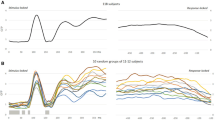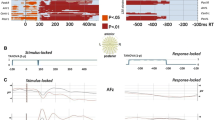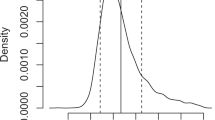Abstract
Most EEG studies analysing speech production with event related brain potential (ERP) have adopted silent metalinguistic tasks or delayed or tacit picture naming in order to avoid possible artefacts during motor preparation. A central issue in the interpretation of these results is whether the processes involved in those tasks are comparable to those involved in overt speech production. In the present study we addressed a methodological issue about the integration of stimulus-aligned and response-aligned ERPs in immediate overt picture naming in comparison to delayed production, coupled with a theoretical point on the effect of word Age of Acquisition (AoA). High density EEG recordings were used and waveform analyses and spatio-temporal segmentation were combined on stimulus-aligned and response-aligned ERPs. The same sequence and duration of topographic maps appeared in the immediate and delayed production until around 350 ms after picture onset, revealing similar encoding processes until the beginning of phonological encoding, but modulations linked to word AoA were only observed in the immediate production. Considering stimulus-aligned and response-aligned ERPs together allowed to identify that a stable topography starting around 350 ms lasts 30 ms longer for late-acquired than for early-acquired words. This difference falls within the time-window of phonological encoding and its modulation can be linked to the longer production latencies for late-acquired words.



Similar content being viewed by others
Notes
Zevin and Seidenberg (2002) raised important concerns regarding to the way these two variables (lexical frequency and AoA) might be confused and made specific suggestions about their operationalisation. For lexical frequency they recommended the use of cumulative frequency (the frequency of word use throughout the life span, from childhood to adulthood): for AoA they suggested to use frequency trajectory measures instead of the age at which a speaker learns a specific word. Frequency trajectory codes AoA in terms of the variation of frequencies throughout the life span.
References
Alario FX, Ferrand L (1999) A set of 400 pictures standardized for French: norms for name agreement, image agreement, familiarity, visual complexity, image variability, and age of acquisition. Behav Res Methods Instrum Comput 31:531–552
Alario FX, Ferrand L, Laganaro M, New B, Frauenfelder UH, Segui J (2004) Predictors of picture naming speed. Behav Res Methods Instrum Comput 36:140–155
Andrews S, Heathcote A (2001) Distinguishing common and task-specific processes in word identification: a matter of some moment? J Exp Psychol Learn Mem Cogn 27:514–544
Baayen RH, Davidson DJ, Bates DM (2008) Mixed-effects modeling with crossed random effects for subjects and items. J Mem Lang 59:390–412
Bates DM, Sarkar D (2007) Lmer4: linear mixed-effects models using S4 classes. R package version 0.99875-6
Belke E, Brysbaert M, Meyer AS, Ghyselinck M (2005) Age of acquisition effects in picture naming: evidence for a lexical-semantic competition hypothesis. Cognition 96:B45–B54
Boersma P, Weenik D (2007) Praat: doing phonetics by computer. Institute of Phonetic Sciences of the University of Amsterdam. http://www.praat.org
Bonin P, Fayol M, Gombert JE (1998) An experimental study of lexical access in writing and in naming isolated words. Int J Psychol 33:269–286
Bonin P, Chalard M, Méot A, Fayol M (2002) The determinants of spoken and written picture naming latencies. Br J Psychol 93:89–114
Bonin P, Peereman R, Malardier N, Méot A, Chalard M (2003) A new set of 299 pictures for psycholinguistic studies: French norms for name agreement, image agreement, conceptual familiarity, visual complexity, image variability, age of acquisition and naming latencies. Behav Res Methods Instrum Comput 35:158–167
Bonin P, Barry C, Méot A, Chalard M (2004) The influence of age of acquisition in word reading and other tasks: a never ending story? J Mem Lang 50:456–476
Britz J, Landis T, Michel CM (2009) Right parietal brain activity precedes perceptual alternation of bistable stimuli. Cereb Cortex 19:55–65
Camen C, Morand S, Laganaro M (2010) Re-evaluating the time course of gender and phonological encoding during silent monitoring tasks estimated by ERP: serial or parallel processing? J Psycholinguist Res 39:35–49
Chalard M, Bonin P (2006) Age-of-acquisition effects in picture naming: Are-they structural and/or semantic in nature? Visual Cogn 13:864–883
Chalard M, Bonin P, Méot A, Boyer B, Fayol M (2003) Objective age-of-acquisition (AoA) norms for a set of 230 objects names in French: Relationships with psycholinguistic variables, the English data from Morrison et al. (1997), and naming latencies. Eur J Cogn Psychol 15:209–245
Cornelissen K, Laine M, Tarkiainen A, Jarvensivu T, Martin N, Salmelin R (2003) Adult brain plasticity elicited by anomia treatment. J Cogn Neurosci 15:444–461
Cuetos F, Barbón A, Urrutia M, Dominguez A (2009) Determining the time course of lexical frequency and age- of-acquisition using ERP. Clin Neurophysiol 120:285–294
Dambacher M, Kliegl R, Hofmann M, Jacobs RM (2006) Frequency and predictability effects on event-related potentials during reading. Brain Res 1084:89–103
Dobel C, Pulvermüller F, Härle M, Cohen R, Köbbel P, Schönle PW, Rockstroh B (2001) Syntactic and semantic processing in the healthy and aphasic human brain. Exp Brain Res 140:77–85
Eulitz C, Hauk O, Cohen R (2000) Electroencephalographic activity over temporal brain areas during phonological encoding in picture naming. Clin Neurophysiol 111:2088–2097
Gerhand S, Barry C (1998) Word frequency effects in oral reading are not merely age-of-acquisition effects in disguise. J Exp Psychol Lean Mem Cogn 24:267–283
Gerhand S, Barry C (1999) Age-of-acquisition effects in speeded word rading. Cognition 73:B27–B36
Goncharova II, McFarland DJ, Vaughan TM, Wolpaw JR (2003) EMG contamination of EEG: spectral and topographical characteristics. Clin Neurophysiol 114:1580–1593
Graves WW, Grabowski TJ, Mehta S, Gordon JK (2007) A neural signature of phonological access: distinguishing the effects of word frequency from familiarity and length in overt picture naming. J Cogn Neurosci 19:617–631
Hauk O, Pulvermüller F (2004) Effects of word length and frequency on the human event-related potential. Clin Neurophysiol 115:1090–1103
Hensel S, Rockstroh B, Berg P, Schonle PW (2004) Left-hemispheric abnormal EEG activity in relation to impairment and recovery in aphasic patients. Psychophysiology 41:394–400
Indefrey P, Levelt WJM (2004) The spatial and temporal signatures of word production components. Cognition 92:101–144
Jescheniak JD, Levelt WJM (1994) Word frequency effects in speech production: retrieval of syntactic information and of phonological form. J Exp Psychol Learn Mem Cogn 20:824–843
Jescheniak JD, Schriefers H, Garrett MF, Friederici AD (2002) Exploring the activation of semantic and phonological codes during speech planning with event-related brain potentials. J Cogn Neurosci 14:951–964
Jescheniak JD, Hahne A, Schriefers H (2003) Information flow in the mental lexicon during speech planning: evidence from event-related brain potentials. Cogn Brain Res 15:261–276
Johnston RA, Barry C (2005) Age of Acquisition effects in the semantic processing of pictures. Mem Cognit 33:905–912
Kittredge AK, Dell GS, Verkuilen J, Schwartz MF (2008) Where is the effect of frequency in word production? Insights from aphasic picture-naming errors. Cogn Neuropsychol 25:463–492
Koester D, Schiller NO (2008) Morphological priming in overt language production: electrophysiological evidence from Dutch. Neuroimage 42:1622–1630
Kronbichler M, Hutzler F, Wimmer H, Mair A, Staffen W, Ladurner G (2004) The visual word form area and the frequency with which words are encountered: evidence from a parametric fMRI study. Neuroimage 21:946–953
Laganaro M, Morand S, Schnider A (2009) Time course of evoked-potential changes in different forms of anomia in aphasia. J Cogn Neurosci 21:1499–1510
Lehmann D, Skrandies W (1984) Spatial analysis of evoked potentials in man—a review. Prog Neurobiol 23:227–250
Lété B, Sprenger-Charolles L, Colé P (2004) MANULEX: a grade-level lexical database from elementary school readers. Behav Res Methods Instrum Comput 36:156–166
Levelt WJM, Praamstra P, Meyer AS, Helenius P, Salmelin R (1998) An MEG study of picture naming. J Cogn Neurosci 10:553–567
Maess B, Friederici AD, Damian M, Meyer AS, Levelt WJM (2002) Semantic category interference in overt picture naming: sharpening current density localization by PCA. J Cogn Neurosci 14:455–462
Michel CM, Thut G, Morand S, Khateb A, Pegna AJ, Grave de Peralta R (2001) Electric source imaging of human brain functions. Brain Res 36:108–118
Michel CM, Murray MM, Lantz G, Gonzalez S, Spinelli L, Grave de Peralta R (2004) EEG source imaging. Clin Neurophysiol 115:2195–2222
Michel CM, Koenig T, Brandeis D, Gianotti LRR (2009) Electric neuroimaging. Cambridge University Press, Cambridge
Morrison CM, Ellis AW (1995) Roles of word frequency and age of acquisition in word naming and lexical decision. J Exp Psychol Learn Mem Cogn 21:116–133
Morrison CM, Ellis AW, Quinlam PT (1992) Age of acquisition, not word frequency, affects object naming, not object recognition. Mem Cognit 20:705–714
Murray MM, Camen C, Gonzalez ASL, Bovet P, Clarke S (2006) Rapid brain discrimination of sounds of objects. J Neurosci 26:1293–1302
Murray MM, Brunet D, Michel C (2008) Topographic ERP analyses, a step-by-step tutorial review. Brain Topogr 20:249–269
New B, Pallier C, Brysbaert M, Ferrand L (2004) Lexique2: a new French lexical database. Behav Res Methods Instrum Comput 36:516–524
Oldfield RC (1971) The assessment and analysis of handedness: the Edinburgh inventory. Neuropsychologia 9:97–113
Oldfield RC, Wingfield A (1965) Response latencies in naming objects. Q J Exp Psychol 17:273–281
Pascual-Marqui RD, Michel CM, Lehmann D (1995) Segmentation of brain electrical activity into microstates: model estimation and validation. IEEE Trans Biomed Eng 42:658–665
Pinheiro JC, Bates DM (2000) Mixed-effects models in S and S-PLUS. Springer, New York
R-development core team (2007) R: a language and environment for statistical computing. R Foundation of Statistical Computing, Vienna. http://www.R-projct.org
Rodriguez-Fornells A, Schmitt BM, Kutas M, Münte TF (2002) Electrophysiological estimates of the time course of semantic and phonological encoding during listening and naming. Neuropsychologia 40:778–787
Schmitt BM, Münte TF, Kutas M (2000) Electrophysiological estimates of the time course of semantic and phonological encoding during implicit picture naming. Psychophysiology 37:473–484
Schnider A, Mohr C, Morand S, Michel CM (2007) Early cortical response to behaviorally relevant absence of anticipated outcomes: a human event-related potential study. Neuroimage 35:1348–1355
Strijkers K, Costa A, Thierry G (2010) Tracking lexical access in speech production: electrophysiological correlates of word frequency and cognate effects. Cereb Cortex 20:912–928
Tainturier MJ, Tamminen J, Thierry G (2005) Age of acquisition modulates the amplitude of the P300 component in spoken word recognition. Neurosci Lett 379:17–22
Van Turennout M, Hagoort P, Brown CM (1998) Brain activity during speaking: from syntax to phonology in 40 milliseconds. Science 280:572–754
Van Turennout M, Hagoort P, Brown CM (1999) The time course of grammatical and phonological processing during speaking: evidence from event-related brain potentials. J Psycholinguist Res 28:649–676
Vihla M, Laine SM, Salmelin R (2006) Cortical dynamics of visual/semantic vs. phonological analysis in picture naming. Neuroimage 33:732–738
Whitham EM, Pope KJ, Fitzgibbon SP, Lewis T, Clark CR, Loveless S, Broberg M, Wallace A, DeLosAngeles D, Lillie P, Hardy A, Fronsko R, Pulbrook A, Willoughby JO (2007) Scalp electrical recording during paralysis: quantitative evidence that EEG frequencies above 20 Hz are contaminated by EMG. Clin Neurophysiol 118:1877–1888
Zevin JD, Seidenberg MS (2002) Age-of-acquisition effects in word reading and other task. J Mem Lang 47:1–29
Zevin JD, Seidenberg MS (2004) Age-of-acquisition effects in reading aloud: tests of cumulative frequency and frequency trajectory. Mem Cognit 32:31–38
Zhang Q, Damian MF (2009) The time course of segment and tone encoding in Chinese spoken production: an event-related potential study. Neuroscience 163:252–265
Acknowledgment
This research was supported by Swiss National Science Foundation grant no. PP001-118969/1. The Cartool software (http://brainmapping.unige.ch/Cartool.php) has been programmed by Denis Brunet, from the Functional Brain Mapping Laboratory, Geneva, Switzerland, and is supported by the Center for Biomedical Imaging (CIBM) of Geneva and Lausanne. The authors thank Violaine Michel for her help with data acquisition and pre-analysis, as well as Christoph Michel for his comments on a previous version of the manuscript.
Author information
Authors and Affiliations
Corresponding author
Rights and permissions
About this article
Cite this article
Laganaro, M., Perret, C. Comparing Electrophysiological Correlates of Word Production in Immediate and Delayed Naming Through the Analysis of Word Age of Acquisition Effects. Brain Topogr 24, 19–29 (2011). https://doi.org/10.1007/s10548-010-0162-x
Received:
Accepted:
Published:
Issue Date:
DOI: https://doi.org/10.1007/s10548-010-0162-x




